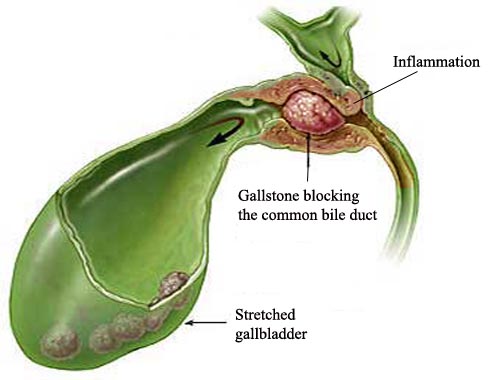Bile duct inflammation (Ascending cholangitis)

Published: 18 Jun 2025
ICD9: 576.8 ICD10: K83.8 ICD11: DC13
Ascending cholangitis, or simply cholangitis, is a serious infection of the bile duct system.
Let's break down what that means:
![]() Bile Ducts: These are a network of tubes that carry bile, a digestive fluid produced by the liver, to the gallbladder and then into the small intestine. Bile helps break down fats.
Bile Ducts: These are a network of tubes that carry bile, a digestive fluid produced by the liver, to the gallbladder and then into the small intestine. Bile helps break down fats.
![]() Inflammation: This refers to swelling and irritation of the bile duct walls.
Inflammation: This refers to swelling and irritation of the bile duct walls.
![]() Ascending: This means the infection is "ascending" or traveling upwards from the small intestine, where bacteria normally reside, into the bile ducts.
Ascending: This means the infection is "ascending" or traveling upwards from the small intestine, where bacteria normally reside, into the bile ducts.
In simple terms, ascending cholangitis is a bacterial infection that travels up the bile ducts, causing inflammation and potentially life-threatening complications.
Causes:
The most common cause is a blockage in the bile duct. This blockage allows bacteria to accumulate and thrive in the bile ducts. Common causes of blockage include:
![]() Gallstones: These are hardened deposits that can form in the gallbladder and block the bile ducts.
Gallstones: These are hardened deposits that can form in the gallbladder and block the bile ducts.
![]() Bile duct strictures: Narrowing of the bile ducts due to scarring from previous surgery, inflammation, or other conditions.
Bile duct strictures: Narrowing of the bile ducts due to scarring from previous surgery, inflammation, or other conditions.
![]() Tumors: Cancerous or non-cancerous growths that can obstruct the bile ducts.
Tumors: Cancerous or non-cancerous growths that can obstruct the bile ducts.
![]() Medical procedures: Certain procedures, such as ERCP (endoscopic retrograde cholangiopancreatography), can sometimes introduce bacteria into the bile ducts or cause inflammation.
Medical procedures: Certain procedures, such as ERCP (endoscopic retrograde cholangiopancreatography), can sometimes introduce bacteria into the bile ducts or cause inflammation.
Symptoms:
The classic symptoms of ascending cholangitis are known as Charcot's triad:
1. Right upper quadrant abdominal pain: Pain in the upper right part of your abdomen.
2. Fever: Often with chills.
3. Jaundice: Yellowing of the skin and whites of the eyes.
However, not all patients present with all three symptoms. Severe cases may also include:
![]() Altered mental status: Confusion, disorientation, or drowsiness.
Altered mental status: Confusion, disorientation, or drowsiness.
![]() Septic shock: A life-threatening condition caused by the body's overwhelming response to infection, leading to dangerously low blood pressure and organ dysfunction.
Septic shock: A life-threatening condition caused by the body's overwhelming response to infection, leading to dangerously low blood pressure and organ dysfunction.
When altered mental status and septic shock are present, along with Charcot's triad, it is referred to as Reynold's Pentad.
Diagnosis:
Diagnosis usually involves:
![]() Medical history and physical exam: The doctor will ask about your symptoms and examine you.
Medical history and physical exam: The doctor will ask about your symptoms and examine you.
![]() Blood tests: To check for signs of infection, liver function, and inflammation.
Blood tests: To check for signs of infection, liver function, and inflammation.
![]() Imaging studies:
Imaging studies:![]()

![]() Ultrasound: Often the first test done to look for gallstones or other blockages.
Ultrasound: Often the first test done to look for gallstones or other blockages.![]()

![]() CT scan or MRI: Provides more detailed images of the bile ducts and surrounding structures.
CT scan or MRI: Provides more detailed images of the bile ducts and surrounding structures.![]()

![]() ERCP (endoscopic retrograde cholangiopancreatography): A procedure where a scope is inserted through the mouth to visualize the bile ducts and pancreas. It can also be used to take samples or remove blockages.
ERCP (endoscopic retrograde cholangiopancreatography): A procedure where a scope is inserted through the mouth to visualize the bile ducts and pancreas. It can also be used to take samples or remove blockages.
Treatment:
Ascending cholangitis is a medical emergency that requires prompt treatment, which typically involves:
1. Antibiotics: To fight the infection.
2. Bile duct drainage: To relieve the blockage and allow the infected bile to drain out. This is usually done using:![]()

![]() ERCP: A stent (small tube) can be placed to keep the bile duct open.
ERCP: A stent (small tube) can be placed to keep the bile duct open.![]()

![]() Percutaneous transhepatic biliary drainage (PTBD): A needle is inserted through the skin into the liver to drain the bile duct.
Percutaneous transhepatic biliary drainage (PTBD): A needle is inserted through the skin into the liver to drain the bile duct.![]()

![]() Surgery: May be necessary in some cases to remove the blockage or repair the bile duct.
Surgery: May be necessary in some cases to remove the blockage or repair the bile duct.
3. Supportive care: Intravenous fluids, pain medication, and other measures to support the body's functions.
Complications:
If left untreated, ascending cholangitis can lead to serious complications, including:
![]() Sepsis: A life-threatening systemic infection.
Sepsis: A life-threatening systemic infection.
![]() Liver abscess: A collection of pus in the liver.
Liver abscess: A collection of pus in the liver.
![]() Acute liver failure: The liver suddenly stops functioning.
Acute liver failure: The liver suddenly stops functioning.
![]() Death.
Death.
In summary, ascending cholangitis is a serious infection of the bile ducts that requires prompt diagnosis and treatment. If you experience symptoms such as right upper quadrant abdominal pain, fever, and jaundice, seek immediate medical attention.
Important Note: This information is for educational purposes only and should not be considered medical advice. Always consult with a qualified healthcare professional for any health concerns or before making any decisions related to your health or treatment.